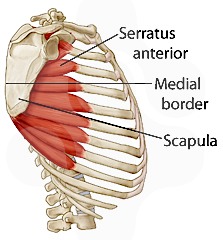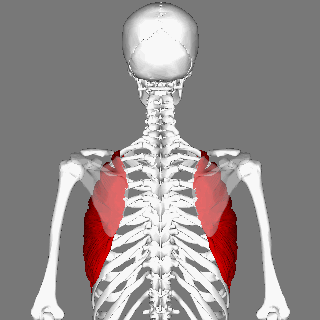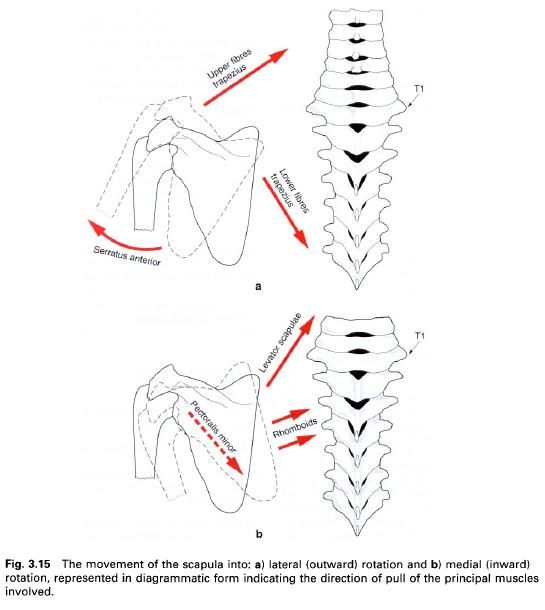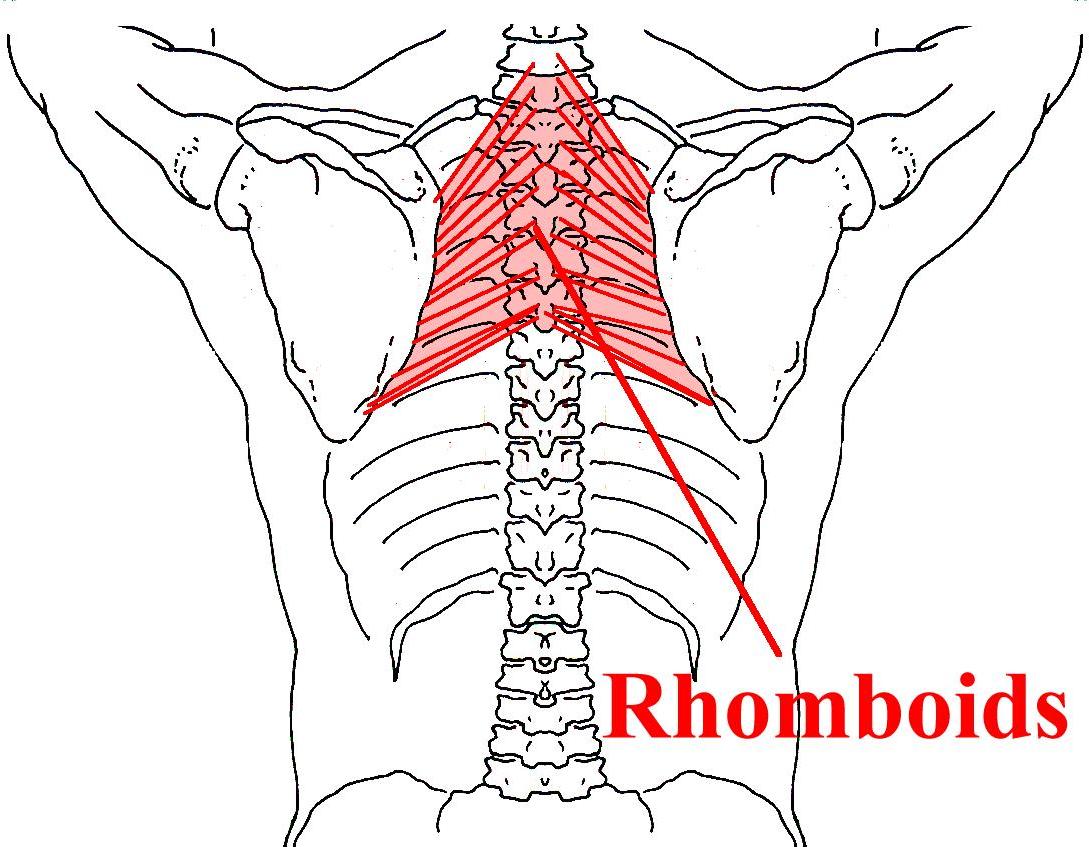by Brent Brookbush DPT, PT, MS, PES, CES, CSCS, ACSM H/FS
Lesson 6: Scapular Muscles Lecture
Study Guide – Quick Reference – Muscles of the Scapula
Note: If you intend to do the activities below do not open the “Study Guide” – all the answers are already filled in. The study guide is just a quick reference tool, similar to flash cards – great for preparing for an exam.
Introduction:
In this lecture we will be discussing:
- Serratus anterior
- Pectorlis Minor
- Trapezius
- Levator Scapulae
- Trapezius
What joint do these muscles cross?
These muscles originate on the rib cage (axial skeleton) and insert into the scapula, and may be referred to as Axial Scapular Muscles. These muscles are responsible for motion of the scapula and shoulder girdle (occasionally referred to as the scapulothoracic joint, but actually the combined motion of the sternoclavicular and acromioclavicular joints – for a review head to Lesson 4). Note: these muscles do not cross the shoulder/glenohumeral joint! Before we start analyzing the function of each muscle, make a word bank for yourself. What are the joint actions of the scapula? The muscles in this lecture must perform joint actions in this word bank… they cannot perform any other actions. For example, there is no such thing as flexion of the scapula.
- Frontal Plane Joint Actions:
- Transverse Plane Plane Joint Actions:
- Sagittal Plane Plane Joint Actions:
You did a similar exercise in a previous lesson Joints of the Shoulder Girdle and Scapular Joint Actions:
- Worksheet – Scapular Joint Actions and Exercises
- Answer Key – Scapular Joint Actions and Exercises Answer Key
Serratus Anterior:
Etymology:
- serrate (adj.) “notched,” 1660s, from Latin serratus “sawlike, notched like a saw,” from serra “a saw,” of unknown origin. Related: Serrated; serrating. (Etymology Online)
- anterior (adj.) 1610s, Latin, literally “former,” comparative of ante “before” (see ante). Related: Anteriority. (Etymology Online)
- Notched muscle on the front

Serratus Anterior – http://www.shoulderdoc.co.uk/images/uploaded/lateral%20view2.jpg
Attachments:
- Origin: Upper 8 or 9 ribs
- Insertion: Anterior medial border of Scapula
Activity:
You determine the actions –
- Printable PDF of Activity – Serratus Anterior Worksheet
- Answer Key – Serratus Anterior Answer Key
- What direction (plane) do most of the fibers of the serratus anterior run?
- Highlight the joint actions that occur in that plane (Does that narrow down your choices?)?
- When the muscle shortens which directions will it pull the scapula? (If you are having a hard time with this step consider your favorite chest exercise?)
- What is the name of the joint action (highlighted above) that occurs in that same direction?
- What might the serratus anterior do in the frontal plane?
- Re-write your answers into one succinct table?
- Check your answers.

Serratus Anterior – http://upload.wikimedia.org/wikipedia/commons/3/31/Serratus_anterior_muscle_animation_small.gif
Pectoralis minor:
Etymology
- pectoral (n.) early 15c., “ornament worn on the breast,” from Middle French pectoral and directly from Latin pectorale “breastplate,” noun use of neuter of adjective pectoralis (see pectoral (adj.)). – As a shortened form of pectoral muscle, attested from 1758. Slang shortening pec for this is first recorded 1966. Related: Pectorals; pecs. (Etymology Online)
- minor (adj.) early 13c., menour “Franciscan” (see minor (n.)), from Latin minor “less, lesser, smaller, junior,” figuratively “inferior, less important,” formed as a masculine/feminine form of minus on the mistaken assumption that minus was a neuter comparative, from PIE root *mei- (2) “small” (see minus). (Etymology Online)
- “Smaller of the muscles “worn” on the chest

Pectorlis Minor – http://classconnection.s3.amazonaws.com/36/flashcards/2412036/png/pectoralis_minor1334173623776-14226B123FE272119E3.png
Attachments:
- Origin: Ribs 3, 4, and 5
- Insertion: Coracoid process
Activity:
You determine the actions –
- Printable PDF of Activity – Pectoralis Minor Worksheet
- Answer Key – Pectoralis Minor Answer Key
- What direction (plane) do the fibers of the pectoralis minor pull?
- What are the names of the joint actions (highlighted above) that occur in that same direction?
- The pectoralis minor attaches on the front of the body. What actions may that allow the pectoralis minor to contribute too?
- Re-write your answers into one succinct table?
- Check your answers.

Pectoralis Minor – http://upload.wikimedia.org/wikipedia/commons/7/75/Pectoralis_minor_muscle_and_shoulder_blade.png
Trapezius
Etymology
- trapezius (n.) muscle over the back of the neck, 1704, from Modern Latin trapezius (musculus), masc. adjective from trapezium (see trapezium). (Etymology Online)
- So called from the shape they form, as in tapeziodal

Trapezius – http://fce-study.netdna-ssl.com/images/upload-flashcards/back/8/4/54848603_m.jpg
Attachments:
- O: External occipital protuberance of skull, spinous process C7 and T1-T12
- I: Acromion process, spine of scapula, and lateral 1/3 of clavicle
Note: The trapezius muscle is divided into 3 distinct parts, each capable of a different action (and an additional action being shared by both the upper the lower trapezius)
Activity:
You determine the actions –
- Printable PDF of Activity – Trapezius Worksheet
- Answer Key – Trapezius Answer Key
- What direction (plane) do the fibers of the upper trapezius pull?
- What are the names of the joint actions (highlighted above) that occur in that same direction?
- What about the middle trapezius. What actions would occur when the middle trapezius contracts (may be easier to visualize both middle trapezius muscles contracting simultaneously)?
- What direction do the fibers of the lower trapezius pull?
- What is the name of the joint action that occurs in the same direction?
- If the lower traps pull on the inside corner of the spine of the scapula, and the axis of the scapula is through the center of the scapula (imagine the scapula as a pinwheel) – which direction would the glenoid fossa (shoulder socket) move?
- This is known as what joint action?
- Re-write your answers into one succinct table?
- Check your answers.

Shared Action by the Upper Trapezius, Lower Trapezius and Serratus Anterior
Levator Scapulae:
Etymology
- levator (n.) from medical Latin levator “a lifter,” from Latin levatus, past participle of levare “to raise” (see lever).(Etymology Online)
- scapula (n.) “shoulder blade,” 1570s, Modern Latin, from Late Latin scapula “shoulder,” from Latin scapulae (plural) “shoulders, shoulder blades,” perhaps originally “spades, shovels,” on notion of similar shape, but animal shoulder blades might have been used as scraping tools in primitive times, from PIE *skap-, variant of *skep- “to cut, scrape” (see scabies).(Etymology Online)
- A lifter of the scapulae

Levator Scapulae – http://upload.wikimedia.org/wikipedia/commons/b/bc/Levator_scapulae.png
Attachments
- Origin: Transverse process of C1-C4
- Insertion: Superior medial border of scapula
Activity:
You determine the actions –
- Printable PDF of Activity – Levator Scapulae Worksheet
- Answer Key – Levator Scapulae Answer Key
- What action does the name of the levator scapulae imply?
- If the levator scapulae pulls on superior angle of the scapula, and the axis of the scapula is through the center of the scapula (imagine the scapula as a pinwheel) – which direction would the glenoid fossa (shoulder socket) move?
- This is known as what joint action?
- Re-write your answers into one succinct table?
- Check your answers.

Upward Rotation and Downward Rotation
Rhomboids:
Etymology
- rhombus (n.) 1560s, from Late Latin rhombus, from Greek rhombos “rhombus, rhomb – (source also of Old English weorpan “to throw away”), from root *wer- (3) “to turn, bend” (see versus).(Etymology Online)
- As in the shape of this muscle
Rhomboids – http://upload.wikimedia.org/wikipedia/commons/a/aa/Rhomboidei.PNG
Attachments
- Origin: Spinous processes of C7-T5
- Insertion: Medial border of the scapula
Activity:
You determine the actions –
- Printable PDF of Activity – Rhomboids Worksheet
- Answer Key – Rhomboids Answer Key
- When the rhomboids contract, what action do you think they are best at (may be easier to visualize both middle trapezius muscles contracting simultaneously)?
- If the rhomboids are lengthened in upward rotation, what joint action could they contribute to while shortening?
- With the slightly oblique (diagonal) arrangement of the fibers, would the scapula slightly elevate or slightly depress when the rhomboids contract?
- Re-write your answers into one succinct table?
- Check your answers.

Rhomboids lengthened in upward rotation – https://jordansequillion.files.wordpress.com/2012/08/rhomboids-1.jpg
Activity: Putting It All Together
Fill in the graph below:
- List the joint action, corresponding plane, all of the muscles that will contribute to that joint action, and a sample exercise.
- Printable PDF of Activity – Scapula Muscles – Putting it all together
- Answer Key – Answer Key Scapula Muscles – Putting it all together
The first action has been done for you as a sample:
| Joint Actions | Plane | Muscles Responsible | Sample exercise that includes joint action |
| Elevation | Frontal | Upper Trapezius, Levator Scapulae, Rhomboids | Shrugs |
Комментариев нет:
Отправить комментарий